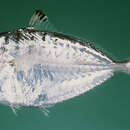Diagnostic Description
provided by Fishbase
Body silvery. Naked head; with nuchal spine. Mouth strongly oblique; nostrils situated above eyes (Ref. 48635). Protracted mouth pointing upward; Tip of maxilla reaching well below level of lower margin of eye. Body depth twice or slightly more than standard length. Lateral line ending before dorsal fin.
- Recorder
- Estelita Emily Capuli
Migration
provided by Fishbase
Amphidromous. Refers to fishes that regularly migrate between freshwater and the sea (in both directions), but not for the purpose of breeding, as in anadromous and catadromous species. Sub-division of diadromous. Migrations should be cyclical and predictable and cover more than 100 km.Characteristic elements in amphidromy are: reproduction in fresh water, passage to sea by newly hatched larvae, a period of feeding and growing at sea usually a few months long, return to fresh water of well-grown juveniles, a further period of feeding and growing in fresh water, followed by reproduction there (Ref. 82692).
Morphology
provided by Fishbase
Dorsal spines (total): 8; Dorsal soft rays (total): 16; Analspines: 3; Analsoft rays: 14
- Recorder
- Estelita Emily Capuli
Trophic Strategy
provided by Fishbase
Occurs in inshore waters of the continental shelf (Ref. 75154). Juveniles and/or adults are found in mangrove creeks, inlets, near inshore and far inshore waters (Ref. 121464). Associated with seagrass (Ref. 118046). Feeds on benthic and planktonic invertebrates (Ref. 4959).
Biology
provided by Fishbase
Schooling species found in shallow waters, usually near the bottom (Ref. 30573). Occasionally enters brackish waters (Ref. 4833, 48635). Swims in loose groups (Ref. 48635). Feeds on zooplankton including copepods, mysids, and larval fishes and crustaceans (Ref. 11441). Sold fresh and dried salted; also used for fishmeal.
Importance
provided by Fishbase
fisheries: commercial

